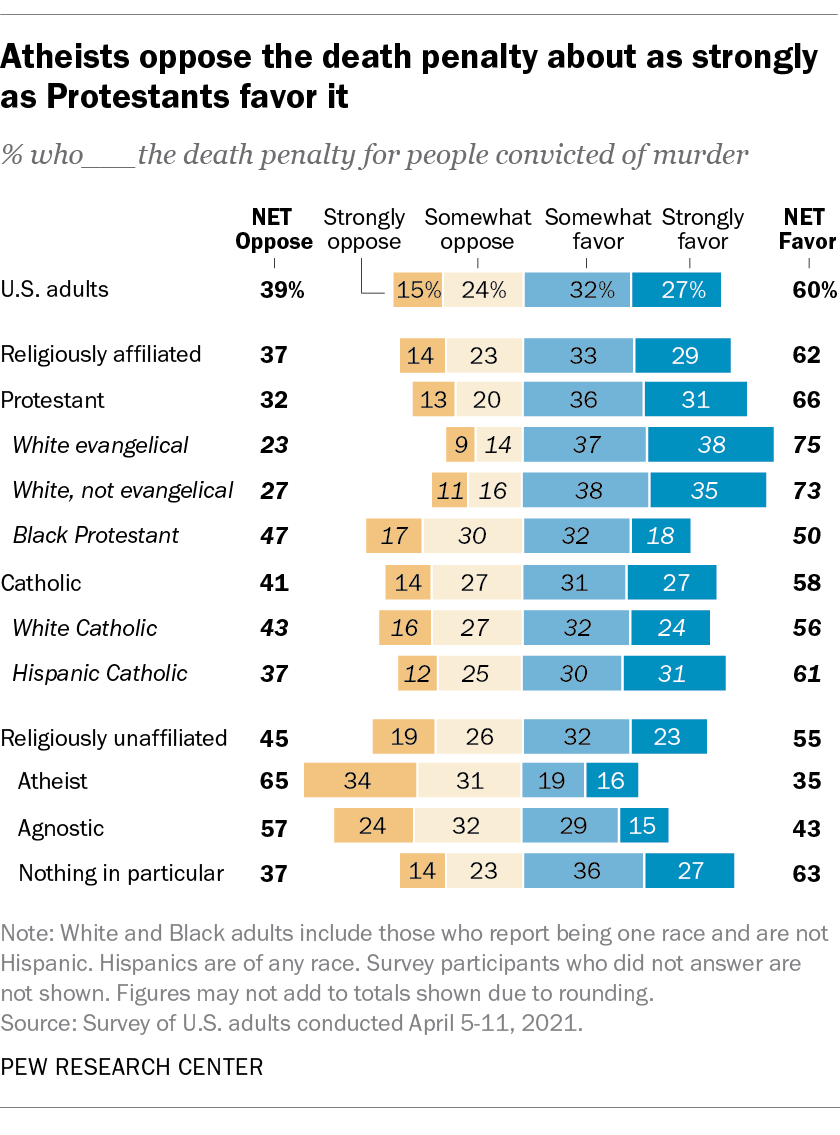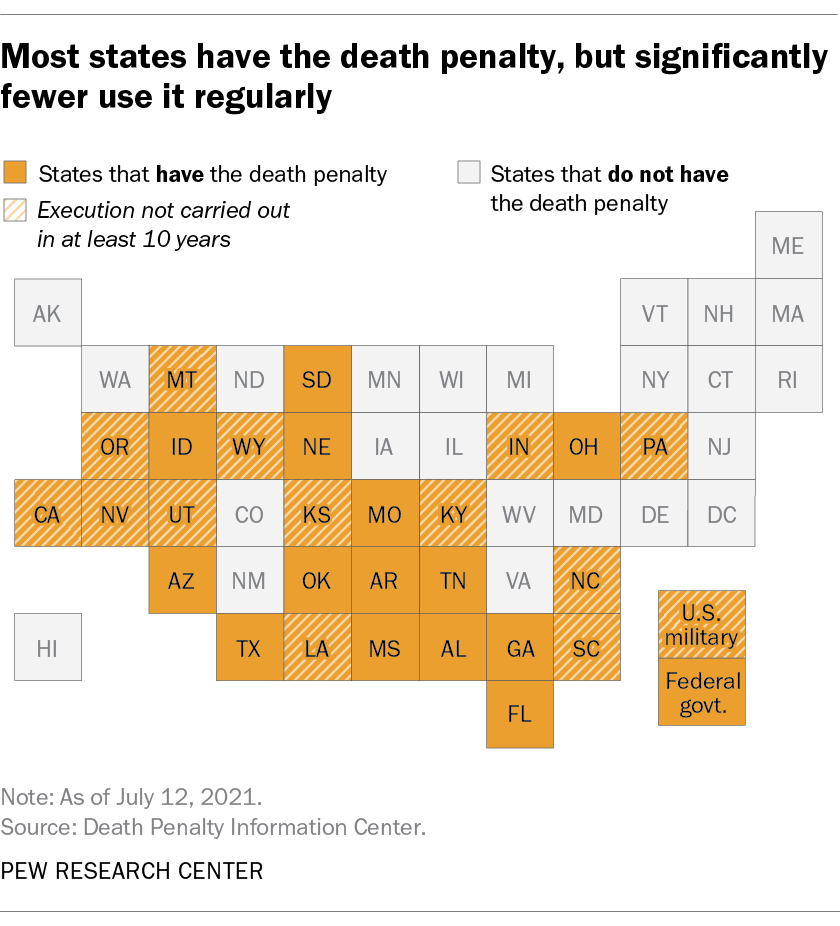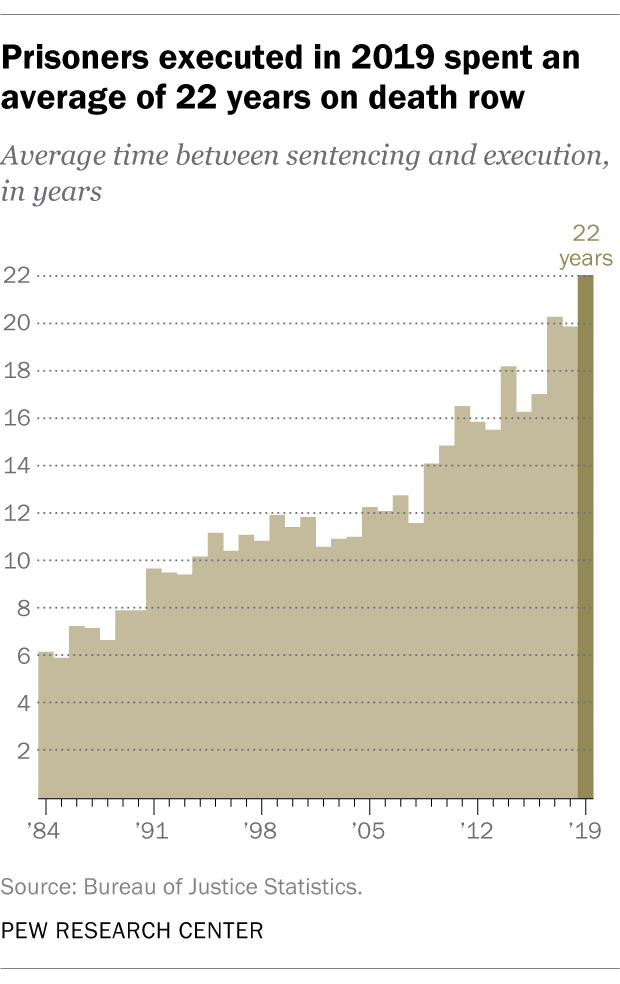
Most U.S. adults support the death penalty for people convicted of murder, according to an April 2021 Pew Research Center survey. At the same time, majorities believe the death penalty is not applied in a racially neutral way, does not deter people from committing serious crimes and does not have enough safeguards to prevent an innocent person from being executed.
Use of the death penalty has gradually declined in the United States in recent decades. A growing number of states have abolished it, and death sentences and executions have become less common. But the story is not one of continuous decline across all levels of government. While state-level executions have decreased, the federal government put more prisoners to death under President Donald Trump than at any point since the U.S. Supreme Court reinstated capital punishment in 1976.
As debates over the death penalty continue in the U.S., here’s a closer look at public opinion on the issue, as well as key facts about the nation’s use of capital punishment.
How we did thisThis Pew Research Center analysis examines public opinion about the death penalty in the United States and explores how the nation has used capital punishment in recent decades.
The public opinion findings cited here are based primarily on a Pew Research Center survey of 5,109 U.S. adults, conducted from April 5 to 11, 2021. Everyone who took part in the survey is a member of the Center’s American Trends Panel (ATP), an online survey panel that is recruited through national, random sampling of residential addresses. This way nearly all U.S. adults have a chance of selection. The survey is weighted to be representative of the U.S. adult population by gender, race, ethnicity, partisan affiliation, education and other categories. Read more about the ATP’s methodology. Here are the questions used from this survey, along with responses, and its methodology.
Findings about the administration of the death penalty – including the number of states with and without capital punishment, the annual number of death sentences and executions, the demographics of those on death row and the average amount of time spent on death row – come from the Death Penalty Information Center and the Bureau of Justice Statistics.
Six-in-ten U.S. adults strongly or somewhat favor the death penalty for convicted murderers, according to the April 2021 survey. A similar share (64%) say the death penalty is morally justified when someone commits a crime like murder.

Support for capital punishment is strongly associated with the view that it is morally justified in certain cases. Nine-in-ten of those who favor the death penalty say it is morally justified when someone commits a crime like murder; only a quarter of those who oppose capital punishment see it as morally justified.
A majority of Americans have concerns about the fairness of the death penalty and whether it serves as a deterrent against serious crime. More than half of U.S. adults (56%) say Black people are more likely than White people to be sentenced to death for committing similar crimes. About six-in-ten (63%) say the death penalty does not deter people from committing serious crimes, and nearly eight-in-ten (78%) say there is some risk that an innocent person will be executed.
Opinions about the death penalty vary by party, education and race and ethnicity. Republicans and Republican-leaning independents are much more likely than Democrats and Democratic leaners to favor the death penalty for convicted murderers (77% vs. 46%). Those with less formal education are also more likely to support it: Around two-thirds of those with a high school diploma or less (68%) favor the death penalty, compared with 63% of those with some college education, 49% of those with a bachelor’s degree and 44% of those with a postgraduate degree. Majorities of White (63%), Asian (63%) and Hispanic adults (56%) support the death penalty, but Black adults are evenly divided, with 49% in favor and 49% opposed.
Views of the death penalty differ by religious affiliation. Around two-thirds of Protestants in the U.S. (66%) favor capital punishment, though support is much higher among White evangelical Protestants (75%) and White non-evangelical Protestants (73%) than it is among Black Protestants (50%). Around six-in-ten Catholics (58%) also support capital punishment, a figure that includes 61% of Hispanic Catholics and 56% of White Catholics.
 Protestants favor it" width="420" />
Protestants favor it" width="420" />
Opposition to the death penalty also varies among the religiously unaffiliated. Around two-thirds of atheists (65%) oppose it, as do more than half of agnostics (57%). Among those who say their religion is “nothing in particular,” 63% support capital punishment.
Support for the death penalty is consistently higher in online polls than in phone polls. Survey respondents sometimes give different answers depending on how a poll is conducted. In a series of contemporaneous Pew Research Center surveys fielded online and on the phone between September 2019 and August 2020, Americans consistently expressed more support for the death penalty in a self-administered online format than in a survey administered on the phone by a live interviewer. This pattern was more pronounced among Democrats and Democratic-leaning independents than among Republicans and GOP leaners, according to an analysis of the survey results.
Phone polls have shown a long-term decline in public support for the death penalty. In phone surveys conducted by Pew Research Center between 1996 and 2020, the share of U.S. adults who favor the death penalty fell from 78% to 52%, while the share of Americans expressing opposition rose from 18% to 44%. Phone surveys conducted by Gallup found a similar decrease in support for capital punishment during this time span.
A majority of states have the death penalty, but far fewer use it regularly. As of July 2021, the death penalty is authorized by 27 states and the federal government – including the U.S. Department of Justice and the U.S. military – and prohibited in 23 states and the District of Columbia, according to the Death Penalty Information Center. But even in many of the jurisdictions that authorize the death penalty, executions are rare: 13 of these states, along with the U.S. military, haven’t carried out an execution in a decade or more. That includes three states – California, Oregon and Pennsylvania – where governors have imposed formal moratoriums on executions.

A growing number of states have done away with the death penalty in recent years, either through legislation or a court ruling. Virginia, which has carried out more executions than any state except Texas since 1976, abolished capital punishment in 2021. It followed Colorado (2020), New Hampshire (2019), Washington (2018), Delaware (2016), Maryland (2013), Connecticut (2012), Illinois (2011), New Mexico (2009), New Jersey (2007) and New York (2004).
Death sentences have steadily decreased in recent decades. There were 2,570 people on death row in the U.S. at the end of 2019, down 29% from a peak of 3,601 at the end of 2000, according to the Bureau of Justice Statistics (BJS). New death sentences have also declined sharply: 31 people were sentenced to death in 2019, far below the more than 320 who received death sentences each year between 1994 and 1996. In recent years, prosecutors in some U.S. cities – including Orlando and Philadelphia – have vowed not to seek the death penalty, citing concerns over its application.
Nearly all (98%) of the people who were on death row at the end of 2019 were men. Both the mean and median age of the nation’s death row population was 51. Black prisoners accounted for 41% of death row inmates, far higher than their 13% share of the nation’s adult population that year. White prisoners accounted for 56%, compared with their 77% share of the adult population. (For both Black and White Americans, these figures include those who identify as Hispanic. Overall, about 15% of death row prisoners in 2019 identified as Hispanic, according to BJS.)

Annual executions are far below their peak level. Nationally, 17 people were put to death in 2020, the fewest since 1991 and far below the modern peak of 98 in 1999, according to BJS and the Death Penalty Information Center. The COVID-19 outbreak disrupted legal proceedings in much of the country in 2020, causing some executions to be postponed.
Even as the overall number of executions in the U.S. fell to a 29-year low in 2020, the federal government ramped up its use of the death penalty. The Trump administration executed 10 prisoners in 2020 and another three in January 2021; prior to 2020, the federal government had carried out a total of three executions since 1976.
The Biden administration has taken a different approach from its predecessor. In July 2021, Attorney General Merrick Garland ordered a halt in federal executions while the Justice Department reviews its policies and procedures.

The average time between sentencing and execution in the U.S. has increased sharply since the 1980s. In 1984, the average time between sentencing and execution was 74 months, or a little over six years, according to BJS. By 2019, that figure had more than tripled to 264 months, or 22 years. The average prisoner awaiting execution at the end of 2019, meanwhile, had spent nearly 19 years on death row.
A variety of factors explain the increase in time spent on death row, including lengthy legal appeals by those sentenced to death and challenges to the way states and the federal government carry out executions, including the drugs used in lethal injections. In California, more death row inmates have died from natural causes or suicide than from executions since 1978, according to the state’s Department of Corrections and Rehabilitation.
Note: This is an update to a post originally published May 28, 2015.